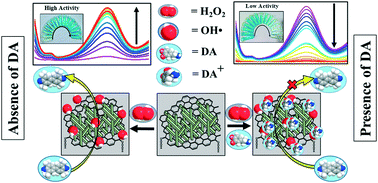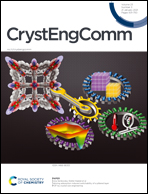Mildly acidic pH and room temperature triggered peroxidase-mimics of rGO–Cu3(OH)2(MoO4)2 cuboidal nanostructures: an effective colorimetric detection of neurotransmitter dopamine in blood serum and urine samples†
Abstract
Cu3(OH)2(MoO4)2 cuboidal nanostructures (CMCNs) and their rGO/CMCNs nanocomposites have been synthesized by a simple hydrothermal route. These nanostructures show excellent enzyme mimicking activity at mildly acidic pH and room temperature. The colorimetric detection of dopamine has been done by analyzing the oxidation of the colorless TMB peroxidase substrate to the corresponding blue-colored product in the presence of H2O2. The long-term stability and robustness of the rGO/CMCNs nanocomposite have also been examined by maintaining the pH (acidic to basic) and temperature. The presence of H2O2 generated hydroxyl free radicals (˙OH), the main reactive species, which was validated using the scavenger isopropanol. Further, rGO/CMCNs-assisted TMB oxidation offers a platform for the colorimetric detection of dopamine. Dopamine captures ˙OH free radicals and inhibits the oxidation of TMB which leads to its detection. The limit of detection was found to be 0.17 μM with a linear range of 1–10 μM by colorimetric detection. The present sensing system was also used to quantify the dopamine concentration present in human blood serum and urine samples. rGO/CMCNs nanocomposites provide the significant peroxidase – mimicking activity for dopamine sensing.

- This article is part of the themed collection: Nanomaterials


 Please wait while we load your content...
Please wait while we load your content...